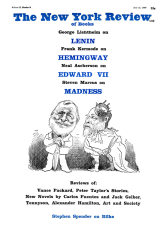The divorce between “Art” and “Society,” a couple, so it seems, blissfully (if sometimes stormily) married for as far back as anyone can remember was first discussed in the second half of the eighteenth century and finally promulgated a hundred years later: recent attempts at reconciliation are not wholly convincing despite the fervor they engender. Quite soon after the first signs of estrangement the analysis of its causes and the charting of its development became a familiar occupation. Here are two more examples of this type of study.
Miss Geraldine Pelles looks rather cursorily at the more familiar painting produced in England and France between 1750 and 1850 from a variety of different viewpoints in the hope of demonstrating “the origins of a modern dilemma.” She has unearthed a few interesting quotations and has an occasional illuminating insight, but on the whole her book is marred by a superficial approach and the most serious errors of fact and judgment. These errors are not the trivial ones to which every work of scholarship is liable, for they often strike at the very heart of her argument. Thus it is true neither that “Fragonard and Greuze never became members of the Academy” (both of them did, though Greuze was only admitted as a genre painter) nor that Géricault’s Raft of the Medusa was bought by the State during his lifetime. Then one must have serious doubts about the historical judgment of an author who can claim that Delacroix’s portrait of George Sand in 1838 illustrates the Romantic artist’s tendency to paint “solitary figures isolated from easy human contacts” in view of the fact that the original canvas showed that lady with her lover Chopin, from whom she was forcibly separated only some years later by a picture collector “soucieux peut-être des bonnes moeurs” (to quote a recent scholar). Nor did David “conceive and design” The Rape of the Sabine Women in “about 1790”; and had he ever painted such a picture (as distinguished from their intervention in an effort to stop the fighting) no one could possibly have interpreted it as “symbolic of the need for reconciliation after the Terror.” And why was the aristocracy “crumbling” when Watteau painted his fêtes-galantes at the beginning of the eighteenth century?
Miss Pelles is also prone to making statements that she totally fails to substantiate. It is very likely, for instance, that in the 1830s and 1840s “there was a widespread desire for grand subjects as the numbers of middle-class persons who aspired to an upper-class style of life increased,” but we are given no evidence to support this opinion, and such a vague generalization is characteristic of the very sort of writing that she justifiably deplores in other authors.
A serious study of the whole phenomenon which she discusses would be one of the most valuable contributions that could possibly be made to the history of modern art. But it would have to embrace a far more extensive knowledge of the period than is here shown and would have to make use of far more elusive documents than are touched upon by Miss Pelles. Originality of material is not in itself a necessary virtue, but a book which deals with what is—despite so much that has been written about it—still only little understood should surely contain at least a few illustrations not to be found in every school manual on the subject.
Mr. Graña’s study is, despite its melodramatic title, a more worthy work. His observations on French writers and society in the middle of the nineteenth century also cover much familiar ground and his style is far from exhilarating, but he does at least provide concrete discussions of some of the problems that need to be faced in any sociological survey of this kind, such as the actual mechanism of the literary market. Though he throws some interesting light on the three writers he picks out for particular study (Stendhal, Flaubert and Baudelaire), his book suffers from a certain naiveté and, as nearly always in such work, from a lack of critical distinction: “Serial novel fees allowed Eugène Sue to spend hours with his tailor discussing fine points of fashion. Baudelaire, a man of equal fastidiousness and surely greater talent, had to bargain unpleasantly with his mother for spending money.” One hopes that that “surely” is meant to imply irony rather than diffidence, but even so a sentence of this kind betrays how much ground must still be traversed before the social historian can really illuminate the complex position of art and letters in the nineteenth century.
This Issue
June 11, 1964



